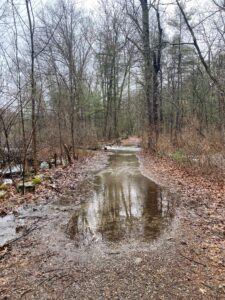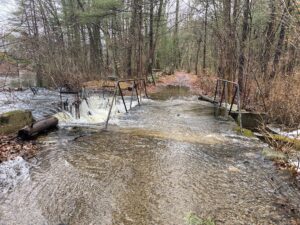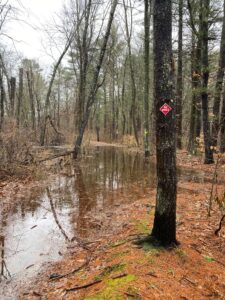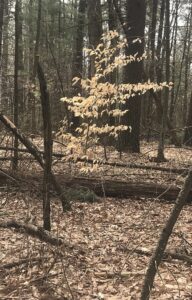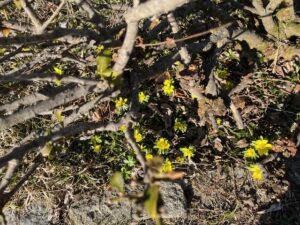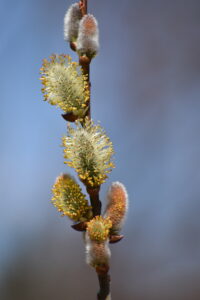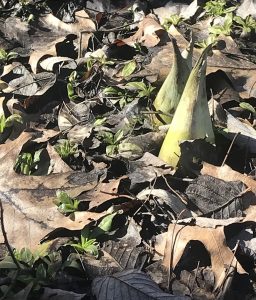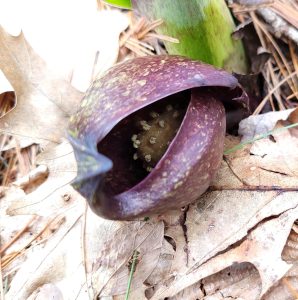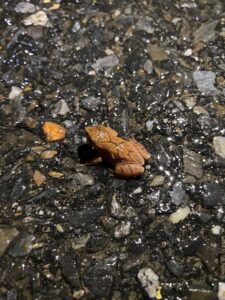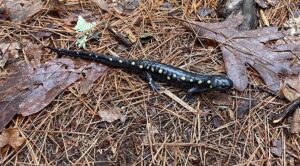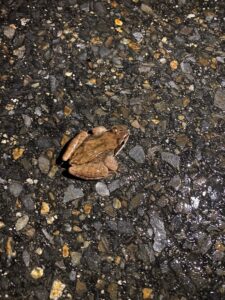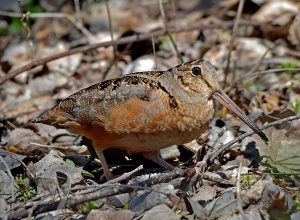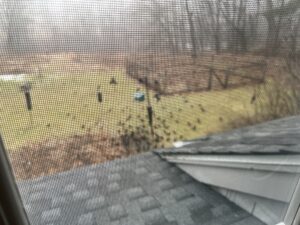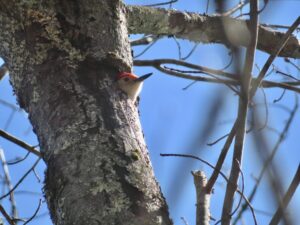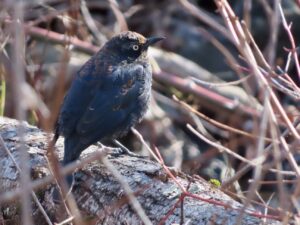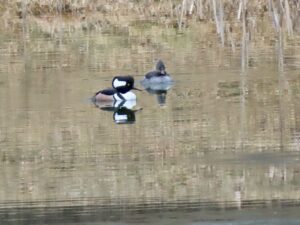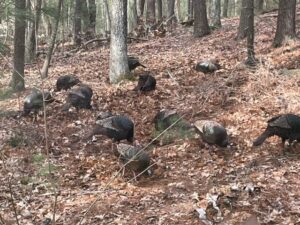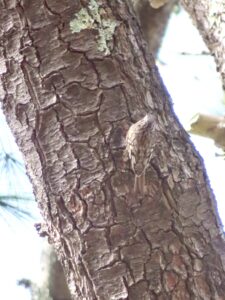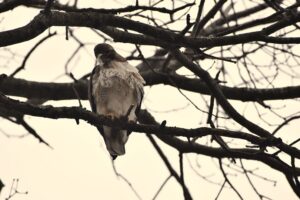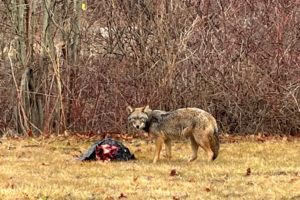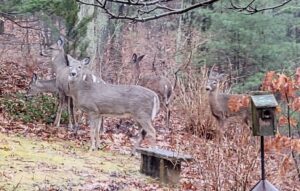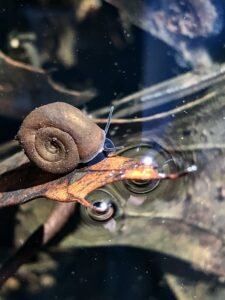Written by Gwyn Loud for the Lincoln Land Conservation Trust. She welcomes your sightings and questions at 781-259-8690 or gwynloud555@gmail.com
Spring will officially arrive on March 19, the vernal equinox, but we have been hearing and seeing signs of the new season for weeks. Maybe the woodchuck was right on Groundhog Day, predicting an early spring. I think many of us are lamenting the absence of “real” winter, no doubt a sign of things to come in the world of climate change. The plant roots and animals such as voles missed the insulating snow cover and my cross-country skis still sit in hope by the door, after little use. We have had a lot of rain recently, leading to some flooded trails and rushing streams.
The blustery days of March allow us to savor each sign of spring as it arrives. Buds are swelling, winter aconite is in bloom, as are crocuses and snowdrops in gardens, and daffodils are poking through the unfrozen ground. The landscape is still mostly drab, brown and gray, but greenery will brighten the scene quickly as warmer temperatures prevail. In the woods, one can still see last year’s leaves on small American Beech trees. Naturalist Mary Holland writes, “Nothing announces the arrival of spring more than willow flowers peaking their silver heads out of the bud scales which have surrounded and protected them all winter. What we call pussy willows are, in fact, the soft, silvery hairs that insulate the emerging spike of flowers, or catkin, within a willow flower bud. Pussy willows are dioecious, meaning there are both male plants and female plants. A male willow has only male catkins; female willows have only female catkins.”
Skunk cabbage continues to emerge near streams, the maroon spathe enlarging to surround the flower created by this unusual plant. As I wrote a year ago, “skunk cabbage is among a small group of plants which produce their own warm micro-climate in a process called thermogenesis. In this process, skunk cabbage increases its intake of oxygen and rapidly burns starch from its massive underground root system, thus creating heat, which it maintains at a steady 72℉, no matter what the outside temperature is. The pollen in the flower provides early food for honeybees, and insects such as carrion beetles, flesh flies, and blowflies are attracted to the skunk cabbage’s fetid carrion-like odor, which is intensified by the plant’s warmth. Several species of spiders then prey upon these insects- a whole food chain happening in a small warm space”.
The annual amphibian migration began during the mild rainy nights the week of March 3 but observers only saw small numbers of wood frogs or spotted salamanders. The proof that some reached their destinations, ready to lay eggs, comes from reports in recent days of singing spring peepers and wood frogs in several locations. If you think you are hearing quacking ducks, it could, instead, be male wood frogs giving their mating calls. It is likely that more amphibians will migrate to their natal vernal pools in the weeks to come, so please drive carefully on wet spring nights to avoid crushing fragile animals which may be on the road.
Red-winged blackbirds are “back” (although some never left this year) giving their characteristic nasal “konka-ree” calls as they prepare to set up nesting territories. American woodcocks have also returned, right on time, and males can be heard giving “peent” calls starting about half an hour after sundown from wet meadows. The male gives an elaborate courtship dance, bobbing in circles on the ground, while peenting, then flying straight up and circling overheated, as air through his wings makes a whistling sound. Next, while giving sharp chirps, he plunges right back to the same spot in the field to give the whole display again. Hopefully, a female will find this alluring!
Flocks of common grackles might descend on your bird feeders as they move north, and migrating American robins will soon spread out on lawns and fields as they search for worms. Killdeer, a member of the plover family and regular spring arrival, have been seen in fields at Drumlin Farm. Wood ducks are back, returning faithfully to breeding sites, in pairs formed on their wintering grounds. Mary Holland writes, “They nest in natural tree cavities, some of which are created by woodpeckers, as well as in artificial nest boxes. (A good reason not to cut standing snags.) Their relatively small size allows them to fit into Pileated Woodpecker holes, their large eyes help them avoid tree branches as they fly and their strong claws aid in perching on tree limbs. Most often their nest cavities are 30 feet or more above the forest floor, and within 50-150 feet of water (although occasionally over a mile away).”
Hooded mergansers, which are also cavity nesters, have been seen on several ponds around town and ring-necked ducks were on Farrar Pond. Also on Farrar Pond, mute swans are working on a couple of nests, and great blue herons have returned. Canada geese are preparing to set up housekeeping on the bank of my neighbor’s pond, as usual. Turkey vultures, moving north have been observed soaring overhead.
Our backyard birds are singing more now as they pair up and start the process of claiming territories. Woodpeckers are drumming and excavating nest holes and pairs of bluebirds are busy checking out bird boxes. House finches might decide that your old Christmas wreath is an ideal nesting spot and Carolina wrens explore nooks and crannies in sheds or gutters to find the right spot to raise a family. Brown creepers are here year-round but they are hard to spot as they are perfectly camouflaged against tree bark. They spiral up tree trunks, foraging for food, then flutter down to the base of another tree to start another upward journey. They are singing now, preparing to build a nest under a flap of bark. Any day now we can expect to hear an Eastern Phoebe, one of our regular early spring arrivals, and tree swallows, swooping gracefully over water or fields, will also be a welcome sight.
Other recent avian sightings of note include a flock of rusty blackbirds (uncommon), stopping on their way north in a wooded swamp along Conant Road and two golden-crowned kinglets spotted near the pre-school at Drumlin Farm. Norm Levey recorded the calls of red-crossbills flying overhead off Virginia Rd. and Virginia rails have also been heard in a couple of places.
Chipmunks, which are not true hibernators, emerged from their winter naps a couple of weeks ago and will breed this month. Many of our other mammal neighbors are also mating now, and fishers and red foxes give birth. Red foxes often use the same den in sandy soil on a wooded bank year after year, while fishers give birth to two or three young, often in a hole in a hollow tree. Several people have reported seeing fishers in recent weeks. (Fishers are not fisher “cats” because they are in the weasel family). At Drumlin Farm there are two melanistic gray squirrels near the sheep barn, one with a white tip on its tail! Over the years melanistic gray squirrels have also been reported from Farrar Pond Village. Coyotes have been seem more frequently in recent weeks at The Commons, no doubt related to their mating season.
Insects will become more noticeable as the weather warms. One of our earliest butterflies, the Eastern comma, was seen by walkers in the woods on Feb. 27, and we can all be watching for the mourning cloak, a butterfly which has over-wintered as an adult and emerges in early spring to mate. Monarch butterflies, which are just starting to head north from their wintering grounds in Mexico, were in serious decline in numbers this winter, down 59%, according to a recent report. According to Monarch Watch, “the size of the eastern monarch butterfly population that overwinters in Mexico is the second smallest on record. The numbers are so low that few monarchs will be seen this coming summer in many parts of the U.S. and Canada.” But monarchs have been resilient in the past so we must not give up. Let’s do what we can to plant milkweed!
Finally, just a reminder to check for ticks when you come home from walks or working in the garden. The ticks are out and about, and have been for most of the winter.
Pertinent Links:
Listen to wood frogs calling (recorded by Nancy Hammond):


